fancystats
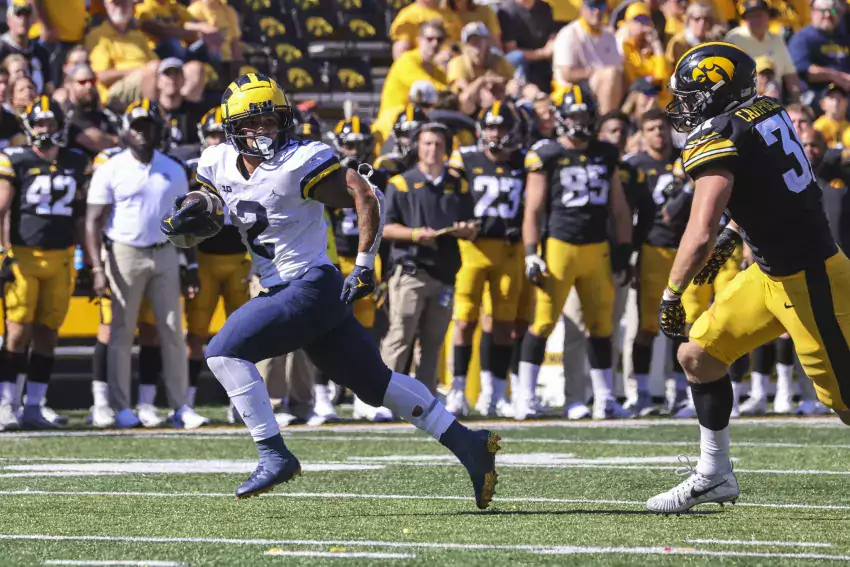
Phonebooks (not that phonebook) are here. Bill Connelly has released his preseason rankings for 2023. Michigan's up there, as you might imagine:
Penn State? I guess Penn State. Drew uber Alles, per SP+. Notable that there is a pretty big gulf between #4 and #5 there, and and even bigger gulf between Penn State and the rest of the Big Ten. The next-best B10 team is Wisconsin at #25, followed by Iowa at 27 and Minnesota at 30. MSU is at 47.
One reason Michigan ranks so high is that they're 5th in returning production and that may undersell it a bit because Connelly's offensive formula has returning RB yards as just 6% of the total. I think that's generally reasonable since RBs are fairly plug and play these days but probably underrates the impact getting Donovan Edwards and Blake Corum back has for M. Let's read a nice thing:
Michigan (third in SP+ in 2022, fifth in returning production in 2023)
When FSU has a chance to be the story, FSU is the story. That's the way these things tend to work. But it's pretty jarring to see a team that made the CFP one year also rank in the top five in returning production the next.The Wolverines are projected to return quarterback J.J. McCarthy, running back and Heisman hopeful Blake Corum and nine of their 12 defenders with 400-plus snaps. Plus, Jim Harbaugh made deft use of the portal, adding reinforcements to both the linebacking corps and an already-awesome offensive line. Both Ohio State and Penn State enter 2023 with hopes of preventing a third straight Big Ten title for Michigan, but they'll have to clear a really high bar.
Yeah. Clear our bar, please. FWIW, Connelly has Michigan at 50/50 to finish 11-1 or better, which means they're about 80-90% to enter the OSU game as a virtual playoff quarterfinal, give or take the backdoor route.
[After THE JUMP: Aussie gonna Aussie.]
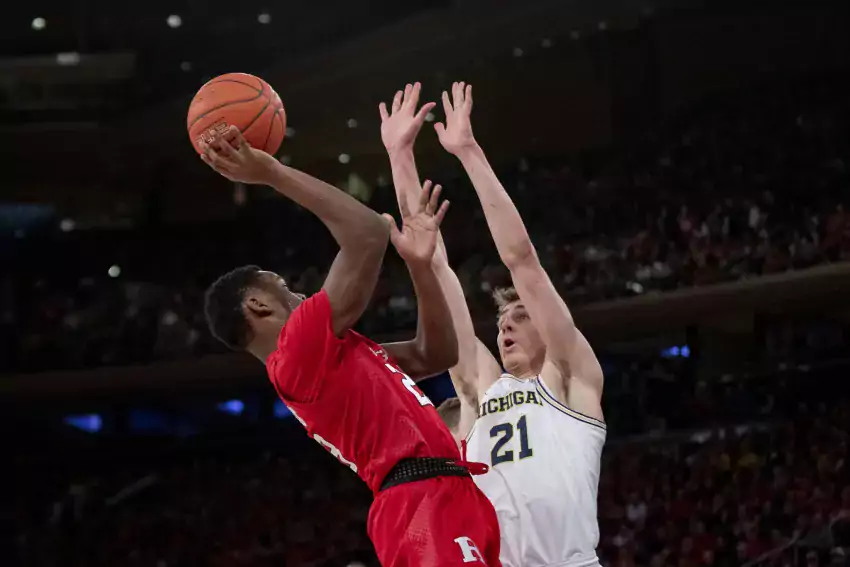
When I was putting together last week's mailbag, Brian forwarded along a question that both hit a topic I've wanted to cover for a while and required an extensive answer.
This seems so counterintuitive...wonder if college vs pro is different due to quality of shooters at pro level. @mgoblog https://t.co/H4L8lTxynY
— Peter Joseph (@PetejoeUM) April 28, 2020
The best defenses in the NBA this year, by and large, are allowing opponents to let fly from three-point range, which goes against the popular recent trend at all levels of basketball—prioritizing guarding the perimeter to help gain an advantage in three-point attempts.
Since John Beilein brought in Billy Donlon and then Luke Yaklich to be his de facto defensive coordinator, Michigan has been among the very best in the country at limiting outside shots, finishing in the top ten in 3PA/FGA the last four seasons. While that approach helped produce top-three overall defenses in 2017-18 and '18-19, the defense took a step back to 28th—not bad, but not elite—in Juwan Howard's first year.
While there were transition costs that helped explain the defensive dropoff, is there a better way to play on that end? Today, I'm going to look at the NBA's trend and whether it applies to college basketball. In my next post, I'll break down what it all means for Michigan and whether Howard's time with the Miami Heat signals that a change is coming.
Talkin' Bout The Bucks
The Milwaukee Bucks were the best team in the NBA in this thus far abbreviated season, going 53-12 with by far the league's best point differential. Having reigning MVP Giannis Antetokounmpo and the league's ninth-ranked offense (by offensive rating) will make a team quite good on its own. What has made the Bucks great, however, is their historically good defense, which ranks nearly four full points per 100 possessions better than the second-best in the NBA.
They've accomplished this even though three-point attempts make up 41.1% of opponent attempts, the third-highest rate in the league. Even when accounting for their great defensive personnel, it's clear coach Mike Budenholzer's tactics play a huge part in their success. Above all else, Milwaukee wants to ensure that opponents don't get a clean look near the rim, and by packing the paint they've become remarkably effective at doing so.
Milwaukee's defense allowed a league-low 29.1% of field goal attempts to come within six feet of the basket, and the gap between them and the #2 team was equal to the gap between #2 and #7. Opponents made only 50.7% of these shots, a ludicrous figure—the #2 team was at 57.3% and the league average if you remove the Bucks was 61.2%.
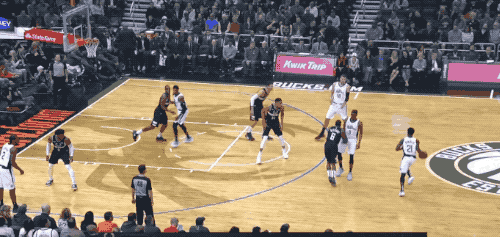
nothing at the rim, ever. [via Mike Prada]
The clip above features one small window where it appears there's a quality look but even that is by design. Number eight in white, Moe Harkless, is a 32% career three-point shooter even though he's mostly taken catch-and-shoot attempts in quality offenses. As the great Mike Prada explained in December, it's all part of the strategy:
Allowing three-pointers doesn’t seem smart, but the Bucks do and still have the best defense in the league. Last year, 36.3 percent of opponent shots were threes, the highest mark in the league. This year, 38.7 percent of them are threes, which is third behind Toronto and Miami. In exchange for turning the rim into a fortress, the Bucks leave the three-point line comparatively unattended. They have transferred all power into the rear deflector shields, so to speak.
Why does this strategy work so well? One reason is that the Bucks allow “good” threes, to the degree that any team can control them. They rank closer to the middle of the pack in corner threes yielded, which are more dangerous, and instead allow the most above-the-break attempts in the league. They specialize in surrendering the semi-open 26-footer from an average stretch big man rather than the in-rhythm corner pop from whiplash ball movement that began with dribble penetration.
(Prada was furloughed by Vox/SBNation and has started his own newsletter. If you're into basketball tactics written for a broad audience, it's greatly recommended.)
There are times when you'll see all five Milwaukee defenders positioned below the free-throw line to stop a drive. Yes, the ballhandler can kick it back out to the top of the key, but firing it to the corner is much more difficult in that scenario. This results in a defense that gives up inefficient looks on average despite so many of them being three-pointers. There are other benefits, too. Here's The Ringer's Zach Kram discussing if the Bucks have the best defense in history:
Cleaning the Glass calculates a stat called “location effective field goal percentage” that asks “if this team allowed the league average FG% from each location, what would their opponents’ effective FG% be?,” which then “gives us a sense of the efficiency of a team’s defensive shot profile.” The Bucks rank third in this metric, narrowly behind Utah and Brooklyn—meaning they would still profile as an elite defense even if they didn’t also have the best defenders at altering shots at the moment of firing. Budenholzer’s game plan works.
A rim-centric defensive philosophy affords the Bucks more advantages than merely forcing opponents into lower-percentage shots; fewer shots near the basket mean fewer realistic opportunities for the opponent to draw a whistle or grab an offensive rebound. The Bucks don’t foul often, with the fourth-lowest opponent free throw rate, and they’re on pace for the best defending rebounding season in NBA history, with Giannis leading the league in defensive rebounds per game.
Milwaukee has elite defenders, but other than Giannis, the main figures weren't necessarily regarded as such until they played for the Bucks—twins Brook and Robin Lopez, for example, are the second- and third- best rim defenders in the league by shot percentage behind, naturally, Giannis. Brook, who's been a revelation as a drop coverage specialist that stonewalls drivers with verticality, was a league-average defender until becoming a top-ten player on that end the last two seasons by most any advanced metric. That directly coincides with his time in Milwaukee.
The Bucks are unique in having Giannis, who's responsible for taking their defense from great to historic. Their success in this approach isn't an isolated case, however. Here are the top ten defenses this season along with their rank in 3PA/FGA:
| Defensive Efficiency | Def. Efficiency Rank | Opponent 3-PT Rate | Opp. 3-PT Rate Rank | |
|---|---|---|---|---|
| Milwaukee | 101.6 | 1 | 41.1 | 3 |
| Toronto | 104.9 | 2 | 43.6 | 1 |
| LA Lakers | 105.5 | 3 | 37.7 | 17 |
| Boston | 106.2 | 4 | 39.9 | 7 |
| LA Clippers | 106.6 | 5 | 39.0 | 9 |
| Philadelphia | 107.6 | 6 | 33.8 | 29 |
| Indiana | 107.7 | 7 | 37.5 | 18 |
| Brooklyn | 108.3 | 8 | 37.1 | 21 |
| Oklahoma City | 108.4 | 9 | 36.8 | 24 |
| Orlando | 108.7 | 10 | 38.6 | 13 |
Four of the top five defenses are also in the top ten by highest opponent three-point rate. There's one defense in here—Philadelphia's—that's an extreme three-point prevention squad and there are two more in the bottom ten of opponent three-point rate. While both approaches can be successful, the very top tier of defenses are taking Milwaukee's approach. (Or they have LeBron James and Anthony Davis.)
[Hit THE JUMP to see how this applies to college ball.]
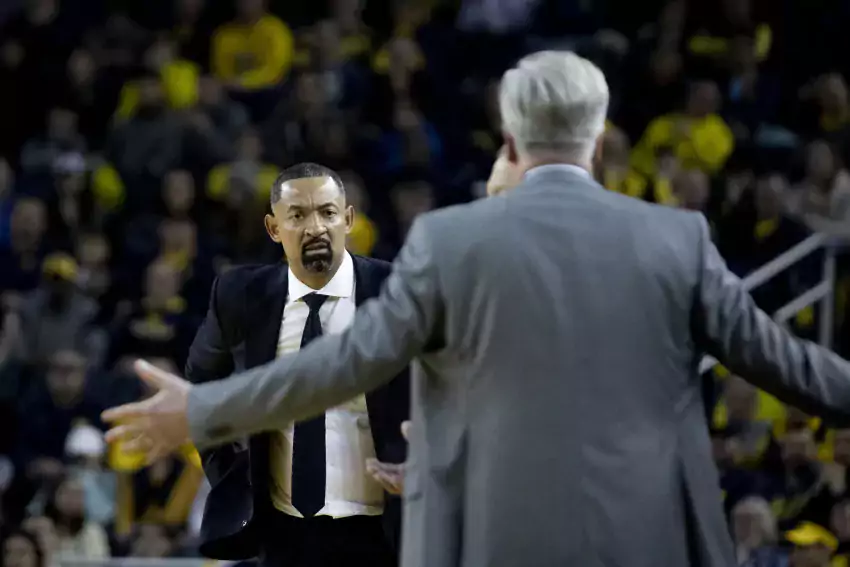
Podcast apologies. I had a family issue and Ace is dealing with a severe allergic reaction, so there's no podcast today. Back at it next week. Silver lining: text content will be novel instead of also on the podcast.
The whiplash game. An alien observer given an oversized baseball hat, trench coat, inconspicuous sunglasses, and tickets to Michigan's two most recent basketball games must think he watched two different sports. One is a game of furrowed brows and vicious close-quarters fighting in which shots are precious and points even more so. The second is superficially similar to the first, but apparently has dozens of subtle rule changes that make it impossible to defend anything. Also your worth as a player is directly correlated with the size of your eyebrows.
I wonder if there's ever been a bigger game-to-game swing in Michigan's offense than going from 0.65 PPP to 1.39. If it's been exceeded it's not by much.
ope just gonna grab this from you for a sec [Campredon]
Johns: hello. One game after I asserted Michigan hadn't changed anything from John Beilein's OREB approach Brandon Johns swoops in for five OREBs and Michigan grabs 44% of its rare misses. Johns also swished a couple corner threes en route to 12 points on seven shot equivalents. Also he had a nice assist to Davis.
That's a breakout performance, and now we're waiting to see if that lasts. It prompted an Athletic article from Brendan Quinn detailing Johns's confidence issues:
“It was a huge problem,” Johns said Friday night, arms folded, standing in the Crisler Center lobby. “It was kind of heartbreaking because people would say how good I am, but I just didn’t see it. I never saw it. I never believed in myself like that.”
When it comes to former top-50 recruits such as Johns, the issue usually comes from the opposite direction. They’re convinced they’re good and need to be broken down. Johns, after a freshman year spent lost in a playbook, confused on the floor and fledgling outside the rotation, was the converse. The picture didn’t fit the frame. He needed to be reminded of who he is and what he can do. He needed to be reminded that he’s 6 feet, 8 inches and 235 pounds of potential. He needed to be told that he’s an elite athlete who can do things others can only dream of.
Johns doesn't have to do a lot more than bring a Mitch McGary vibe and hit open shots to make a big difference as Michigan's primary bench guy at the 3 and 4.
[After THE JUMP: it's raining points]
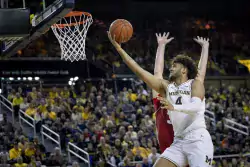
Big Ten baseball should object to everything, like it's a law and order episode
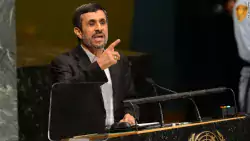
Iran's former president slams Colin Cowherd for skepticism about Harbaugh
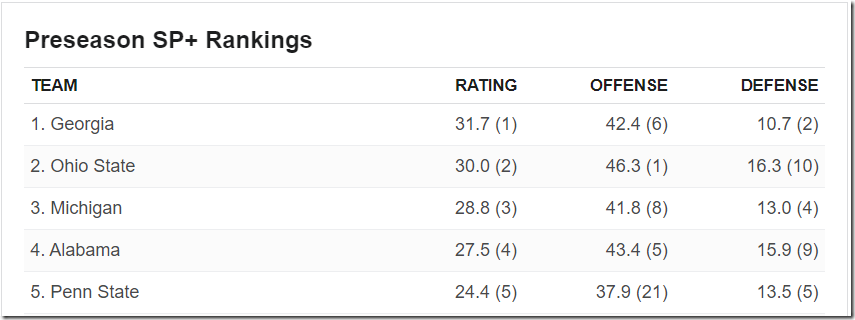

90